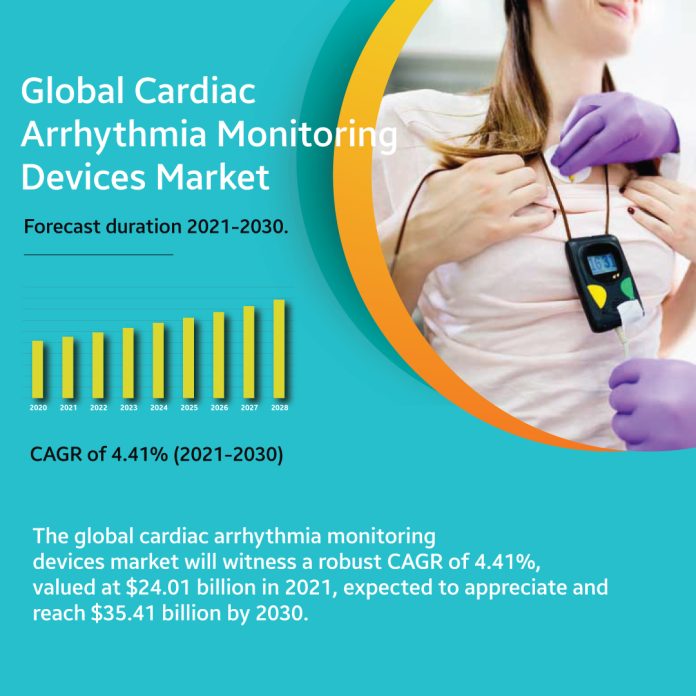Patient’s heart condition is continuously observed with the help of cardiac monitoring devices. These tools are frequently used in intensive care units and emergency rooms, especially to monitor the rate of heartbeats in arrhythmias. Holter monitors, event monitors, loop monitors, and insertable cardiac monitors are examples of common cardiac monitoring equipment types. Blood pressure, cardiac output, intravascular pressures, arterial blood oxygen saturation, and blood temperature are additional parameters that cardiac monitors noninvasively monitor.
The market for cardiac arrhythmia monitoring devices in 2021 was USD 24.01 billion and will be worth USD 35.41 billion by 2030, growing at a 4.41% CAGR during 2021-2030.
Globally increasing rates of serious cardiovascular illnesses will fuel market expansion. The World Health Organization (WHO) estimates that 17.9 million fatalities worldwide occur yearly due to cardiovascular illnesses.
People with severe CVD are more likely to experience arrhythmic disorders like tachycardia and bradycardia, which call for ongoing monitoring to prevent unexpected heart failure. The demand for cardiac arrhythmia monitoring equipment will expand significantly throughout the analysis as the prevalence of cardiac diseases rises.
Most individuals with high arrhythmic risk are monitored with cardiac arrhythmia monitoring equipment. These tools support medical personnel in monitoring irregular heartbeats for better CVD patient diagnosis and therapy to lower associated fatalities.
Drivers
The advancement of technologically improved and novel products will drive the cardiac arrhythmia monitoring devices market.
The development of technologically improved monitoring tools, such as wireless monitors that benefit from early detection, will accelerate industry growth. Due to longer life expectancies and ongoing technological improvements that have increased their capabilities and use, cardiac rhythm monitoring (CRM) devices have considerably increased in recent years. The rate of product approval in developed markets is increasing due to recent advancements in CRM devices, which will further boost industry growth potential.
For instance, Medtronic has gotten permission for its specialized CareLink SmartSync Device Manager, which helps medical professionals manage and program data from its implanted CRM device with BlueSync.
However, factors like the high price of these monitoring devices, the lack of specialists with the necessary skills, and the unfavorable side effects of some cardiac monitoring systems may prevent the market from expanding.
Opportunity
Governments worldwide are investing in the technological advancements of cardiac arrhythmia monitoring devices, which in turn offers various opportunities for the market in the upcoming period. This is due to the continuous rise in cardiovascular diseases.
Market Segmentation
Product Insights
On the basis of product, the market for cardiac arrhythmia monitoring devices is segmented into a Holter monitor, MCT or Mobile cardiac telemetry, ECG devices, Event monitor, COM or Cardiac output monitoring, highly advanced ECG monitors, and Implantable loop recorders.
The Holter monitor segment recorded the largest market share in 2021 and generated revenue of USD 2.8 billion. This is mostly due to the higher incidence of numerous diseases brought on by an increase in the intake of bad foods and unbalanced lifestyles, which negatively affect cardiac health and lead to various types of coronary artery blockages and cardiac arrests.
Type Insights
On the basis of type, the market for cardiac arrhythmia monitoring devices is segmented into defibrillators and pacemakers.
The defibrillators market segment held the largest market share in 2020. It is mainly due to the factors like increasing cases of cardiovascular diseases and technological advancement in defibrillators.
End-User Insights
On the basis of end-user, the market for cardiac arrhythmia monitoring devices is segmented into clinics, hospitals, cardiac centers, ambulatory surgical centers, and others.
In 2021, the hospital segment was the largest market, with a share of 45%. The rising rate of cardiac arrhythmias globally and an aging population will push hospital admission rates for treatment.
Application Insights
On the basis of application, the market for cardiac arrhythmia monitoring devices is segmented into atrial tachycardia, ventricular tachycardia, and tachycardia.
The atrial Tachycardia segment held a maximum position in the market in 2021. It is a form of supraventricular tachycardia that benefits from aggressive therapy. Devices for monitoring cardiac arrhythmias are essential for improving illness diagnosis and treatment. The market for cardiac arrhythmia monitoring devices will experience rapid expansion in the near future due to the rising risk of tachycardia.
Regional Insights
Asia Pacific was the highest regional market in 2021, generating the highest revenue of USD 1.2 billion. Growing patient populations and technological advancements, such as portable and mobile monitoring devices, will drive market demand. The regional market will experience an increase in revenue due to the growing availability of wearable, home-based arrhythmia monitoring devices. Additionally, the region’s business landscape will be driven by the leading and emerging companies expanding operations due to the strong growth potential and larger patient population.
Key Players
- Abbott Laboratories (US)
- Koninklijke Philips (Netherlands)
- BIOTRONIK(Germany)
- Boston Scientific
- Medtronic
- Shenzhen Mindray bio–Medical Electronics
- GE Healthcare
- BPL Medical Technologies
- SCHILLER AG
- MicroPort Scientific corp
- BioTelemetry
- Hill-Rom Holdings
- OSYPKA
- Shree pacetronix
- MeTrax GmbH (Deutschland)
- Asahi Kasei corp
- Nihon Kohden
- ACS Diagnostics
- Narang Medical Limited
- Amiitalia
- Lepu Medical Technology
- RhythMedix
- Progetti Srl
- Been Cardio
- Coala Life
- Alivecor, Inc.
The market for cardiac arrhythmia monitoring devices in 2021 was USD 24.01 billion and will be worth USD 35.41 billion by 2030, growing at a 4.41% CAGR during 2021-2030. The market for cardiac arrhythmia monitoring devices is expected to grow due to several factors, including improvements in technology, rising cardiovascular disease rates, and rising demand for affordable ECG devices.

